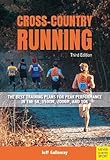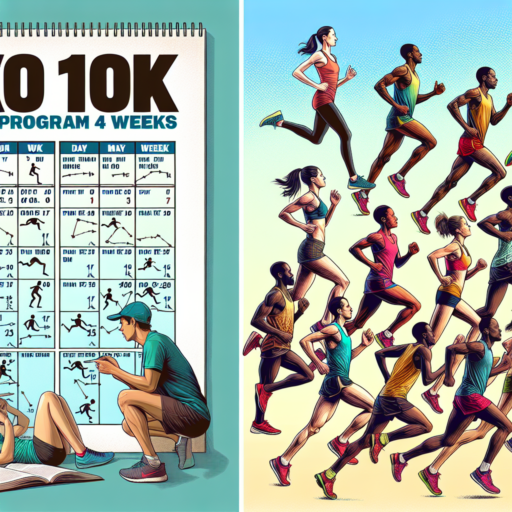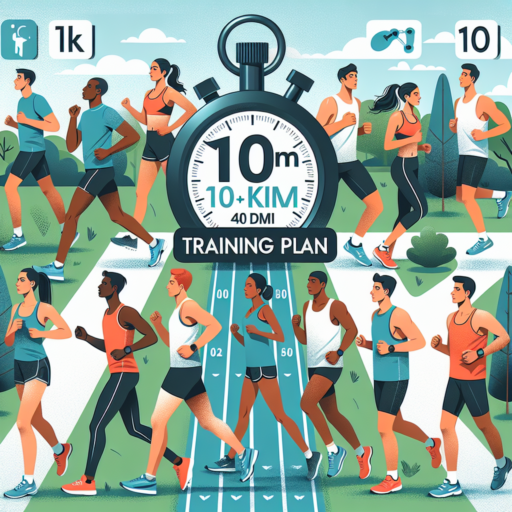Introduction to the 10K Walk Training Plan
Embarking on a 10K walk training plan is an exhilarating journey toward achieving not just a physical feat but also enhancing mental resilience and overall well-being. Beginning such a plan might seem daunting at first, especially for those who are new to long-distance walking or are transitioning from shorter distances. However, laying the foundation with the right approach and understanding the essentials can make this journey enjoyable and significantly more achievable.
The initial phase of adapting to a 10K walk training plan involves familiarizing oneself with the basic structure and goals of the training. This typically includes a mix of short walks, longer distance sessions, and rest days to allow for recovery and muscle adaptation. Emphasizing the importance of a gradual increase in distance, this plan is designed not to overwhelm but to steadily build endurance and strength in a balanced manner.
Equally important is understanding the need for proper gear and support throughout the training. Investing in a good pair of walking shoes that provide adequate support and comfort can make a significant difference in both performance and enjoyment. Furthermore, incorporating elements such as stretching, hydration, and proper nutrition plays a crucial role in maintaining health and optimizing the training experience. By accepting these principles, individuals can navigate the complexities and challenges of the 10K walk training with confidence and enthusiasm.
Benefits of a Tailored 10K Walk Training Schedule
Embarking on a tailored 10K walk training schedule brings with it a plethora of holistic benefits that can significantly enhance your physical health and mental well-being. This specificity in training not only prepares your body for the challenges of a 10K walk but does so in a way that aligns perfectly with your personal needs and goals. The benefits of such a dedicated approach to your training regimen are manifold, touching on everything from improved cardiovascular health to increased mental resilience.
One of the key advantages of a personalized 10K walk training plan is its ability to match your unique fitness level and goals. Unlike generic training schedules, a tailored plan considers your current state of fitness, ensuring that the intensity and volume of training are neither too challenging nor too easy. This specificity helps in systematically improving your endurance and walking efficiency, making your goal not just attainable but sustainable. Furthermore, such customization reduces the risk of injury by acknowledging and respecting your body’s limits and potential for growth.
Another standout benefit of following a tailored 10K walk training schedule is the significant boost it offers to your mental health. Engaging in a structured training program has been shown to enhance mood and alleviate symptoms of anxiety and depression. The regimented yet flexible nature of a personalized plan offers a sense of achievement with each milestone reached, fostering a positive mindset and building mental resilience. This psychological uplift is not just limited to the times you are training; it permeates into other areas of your life, enhancing overall life satisfaction.
Week-by-Week Breakdown of Your 10K Walk Training Plan
Embarking on a 10K walk training plan is a fantastic way to not only improve your physical health but also clear your mind and meet personal milestones. In this week-by-week guide, we’ll walk you through how to gradually increase your walking endurance and strength so you can confidently cross the finish line.
Week 1 to Week 2: The first step toward your 10K goal begins with setting a solid foundation. During the initial weeks, focus on building a routine. Start with 15 to 20-minute walks at a comfortable pace, aiming for consistency rather than speed. It’s crucial at this stage to listen to your body, ensuring you’re not pushing yourself too hard, too soon.
Week 3 to Week 4: Once you’ve established a walking routine, it’s time to gently increase your walking time. Strive for 25 to 30-minute walks, incorporating varying terrain to build strength in different muscle groups. Adding slight inclines or varied paths can make a significant difference in building endurance.
Week 5 to Week 6: By now, your body should be more accustomed to regular walks, allowing you to challenge yourself further. Increase your walking sessions to 35-45 minutes, ensuring you’re maintaining a pace that allows for comfortable conversation. This period is about balancing pushing your limits while ensuring sustainability.
Essential Gear for Your 10K Walk Training
Training for a 10K walk requires not only dedication and discipline but also the right gear to support your journey. Having the essential equipment can make a significant difference in your comfort, performance, and overall experience. Here, we’ll explore the crucial items you should consider incorporating into your 10K walk training regimen.
Comfortable Footwear
At the top of your gear list should be a pair of high-quality walking shoes. Shoes designed specifically for walking offer the necessary support and cushioning that your feet need during long distances. Look for shoes with good arch support, breathable material, and a comfortable fit. Remember, the right footwear can prevent injuries and make your training sessions more enjoyable.
Appropriate Clothing
Whether you’re training in the heat of summer or the coolness of autumn, wearing the right clothing is essential. Opt for lightweight, moisture-wicking fabrics to keep you dry and comfortable no matter the weather. Layering is key for colder conditions, allowing you to remove pieces as your body warms up. Don’t forget to include a light, waterproof jacket for rainy days to ensure your training stays on track.
Hydration and Nutrition Accessories
Staying hydrated and maintaining energy levels are critical aspects of your training. Consider carrying a hydration pack or belt for easy access to water without having to hold a bottle. For longer training sessions, you might also want to bring along energy bars or gels to keep your stamina up. These small but vital accessories can make a big difference in your training effectiveness and overall health.
Incorporating Strength and Flexibility Exercises into Your Training
When it comes to enhancing your overall fitness, the combination of strength and flexibility exercises cannot be overstated. This holistic approach not only contributes to a well-rounded workout routine but also maximizes performance, reduces injury risk, and improves functionality in everyday activities. Let’s delve deeper into how incorporating these exercises can significantly elevate your training regimen.
Integrating strength training aspects, such as weightlifting or bodyweight exercises, builds muscle mass and bone density. This fortification is pivotal for increasing metabolic rate and body composition. Similarly, flexibility exercises like stretching or yoga promote muscle recovery, maintain joint health, and enhance motion range. Together, they ensure a balanced development of your physical capabilities, making your body more resilient and adaptable to various physical demands.
Key Benefits of Combining Strength and Flexibility Training
- Enhanced Athletic Performance: Athletes find that a regime blending both components leads to improvements in speed, agility, and endurance.
- Improved Posture and Balance: This combined approach directly influences core strength, which is crucial for maintaining proper posture and balancing abilities.
- Decreased Risk of Injury: A body that is both strong and flexible is less susceptible to the common injuries associated with physical activities, as muscles and joints are better prepared to handle various stresses.
By understanding the importance and benefits of incorporating strength and flexibility exercises into your training, you set a solid foundation for achieving not only your fitness goals but also promoting long-term health and well-being. Tailoring your workout routine to include a healthy balance of these exercises is essential for reaping the full spectrum of physical fitness benefits.
Nutrition and Hydration Strategies for 10K Walk Training
Preparing for a 10K walk requires not just physical training but also a strategic approach to nutrition and hydration. Understanding the balance of nutrients your body needs and how to stay effectively hydrated can significantly enhance your training experience and performance. It’s not just about eating healthily; it’s about fueling your body in a way that supports endurance, recovery, and overall energy levels.
Optimizing Your Nutrition for Enhanced Performance
When training for a 10K walk, your body needs a well-rounded diet rich in carbohydrates, proteins, and fats. Carbohydrates are particularly crucial as they serve as your body’s primary energy source. Incorporating a variety of complex carbohydrates such as whole grains, vegetables, and fruits into your meals ensures a steady release of energy during your walk. Proteins are essential for muscle repair and recovery, so including lean sources like chicken, fish, beans, and tofu is beneficial. Healthy fats from avocados, nuts, and seeds help with satiety and provide long-lasting energy.
Hydration Before, During, and After Your Walk
Staying hydrated is key to maintaining optimal performance and avoiding heat-related illnesses. Begin hydrating well before your walk, aiming to drink at least 16-20 ounces of water two hours prior. During the walk, a good rule of thumb is to sip about 5-7 ounces of water every 15-20 minutes, adjusting based on weather conditions and personal sweat rate. After completing your walk, replenish any lost fluids by drinking water or electrolyte-enhanced beverages to restore hydration balance and support muscle recovery.
By paying close attention to both nutrition and hydration, you can significantly improve your training outcomes for a 10K walk. Tailoring your diet to meet the specific demands of endurance training, along with optimizing your hydration strategy, are key components of a successful training plan. Remember, the right balance of nutrients and fluids not only supports your physical performance but also enhances your overall health and well-being during the training process.
Common Challenges During 10K Walk Training and How to Overcome Them
Training for a 10K walk is an admirable goal, but it’s not without its hurdles. Many participants encounter a range of common challenges along the way, from physical to psychological barriers. Understanding these obstacles and knowing how to address them can significantly enhance your training experience and performance.
Maintaining Consistent Training
One of the most frequent issues is maintaining a consistent training schedule. Life’s responsibilities often interfere, making it hard to find time for regular workouts. Overcoming this requires commitment and planning. Setting a fixed time each day for your walk, treating it as a non-negotiable part of your day, and preparing your gear the night before can help establish a routine that sticks.
Battling Fatigue and Physical Strain
Physical challenges such as fatigue and strain often emerge, especially for beginners or those upping their distance. Incorporating rest days into your training plan is crucial to allow your body to recover. Additionally, mixing in cross-training activities such as cycling or swimming can prevent overuse injuries by giving your walking muscles a break while still enhancing your cardiovascular fitness.
Measuring Your Progress: Tracking Tools and Tips
Understanding the effectiveness of your strategies is crucial in any digital endeavor, and that’s where the significance of tracking tools comes into play. These tools not only offer an insight into how well your initiatives are performing but also provide actionable data to fine-tune your strategies for better outcomes. From Google Analytics to more specialized software, the choice of tools varies widely, catering to different facets of digital progress measurement.
Starting with the basics, Google Analytics stands as a cornerstone for tracking online performance. It gives a comprehensive view of website traffic, user behavior, and conversion metrics. However, the landscape doesn’t end here. For those looking into SEO-specific metrics, tools like SEMrush and Ahrefs offer in-depth analysis of keyword rankings, backlink profiles, and competitor analysis. These platforms are instrumental in refining your SEO strategy by highlighting areas that need improvement.
Moreover, the advancement in tracking technologies has introduced a variety of specialized tools tailored to specific needs. For instance, heatmap tools like Hotjar provide a visual representation of how users interact with your website, which can be pivotal in optimizing user experience. Similarly, social media analytics tools enable you to gauge the impact of your social media efforts, adjusting your approach as needed.
Employing the right mix of these tools can dramatically reshape your digital strategy, making it more aligned with your goals. Nonetheless, it’s not just about the selection but also about effectively interpreting the data these tools provide. Leveraging these insights can propel your strategies forward, ensuring that your digital footprint not only grows but thrives in an increasingly competitive landscape.
Preparing for Race Day: Tips and Strategies
Getting ready for race day is both exhilarating and nerve-wracking, whether you’re a seasoned marathoner or a first-time racer. With the right approach, you can ensure that your body and mind are primed for the path ahead. Here are essential tips and strategies to help you prepare effectively for the big day.
Setting Achievable Goals
Start by defining clear, achievable goals. Whether it’s aiming to complete the race without stopping, setting a personal best, or simply soaking in the experience, knowing what you want to achieve helps tailor your training and mental preparation. Remember, goals should be realistic, motivating, and measurable to keep you focused and driven.
Optimizing Your Training Plan
An efficient training plan is your blueprint for success on race day. It’s crucial to build your regimen around varied workouts that include long runs, speed work, and recovery days. Importantly, listen to your body and adjust the intensity of your training sessions as needed. Incorporating rest days is vital to prevent overtraining and injuries, ensuring you arrive at the starting line in peak condition.
Nutrition and Hydration Strategies
Eating a balanced diet and staying hydrated are cornerstone elements of race preparation. In the weeks leading up to the race, focus on meals rich in complex carbohydrates, lean proteins, and healthy fats to fuel your training. Equally important is to practice your hydration strategy during long training runs, mimicking race day conditions. This helps you understand how your body responds to different hydration levels, allowing you to adjust your intake accordingly.
Beyond the 10K Walk: Next Steps in Your Fitness Journey
After conquering the commendable milestone of a 10K walk, it’s natural to ponder about what lies beyond in your fitness journey. Advancing from this point isn’t just about adding more kilometers to your walks. It encompasses exploring diverse forms of physical activities, setting new goals, and perhaps, even transforming your dietary habits to support these heightened fitness ambitions.
Finding Your Next Challenge is crucial. Whether it’s transitioning from walking to running, participating in a half-marathon, or exploring different terrains for your walks such as hiking trails, each offers a unique set of benefits and challenges. It’s about pushing your limits but also enjoying the process of discovering what your body can achieve.
Equally important is Investing in Your Fitness Education. Knowledge about the right footwear, understanding the importance of cross-training to prevent injuries, and learning about nutritional needs for higher levels of physical activities can significantly impact your journey. Perhaps, starting a fitness-related course or joining workshops could offer insight and inspiration for your next steps.










